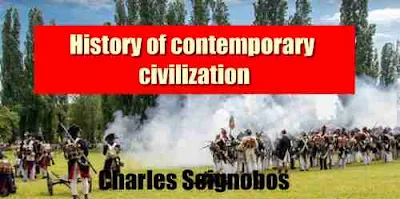History of contemporary civilization
Professor Seignobos has in "Contemporary Civilization" brought the narrative down to the year 1888. It sustains the high level of excellence that distinguishes the volumes on "Ancient Civilization" and "Mediaeval Civilization." Of particular value are the chapters on The European Peoples Outside of Europe; Arts, Letters, and Sciences in the Nineteenth Century; Economic Reforms in France and in Europe; and Democracy and Socialism.
It has been thought best to give as Appendix I, the bibliography used by the author. In Appendix II is to be found a general list of books in the English language on the topics treated. I am under obligation to Miss Margaret Richie Wiseman, of Hardin College, Missouri, for the translation.
It has been the custom to have contemporary civilization begin with the year 1789, and, in fact, the great changes which characterize contemporary civilization appear with the French Revolution. But preparation for these changes was made through a less apparent transformation, which goes back to the beginning of the eighteenth century.
It was, in fact, at the close of the reign of Louis XIV. that those new political doctrines were formed, throughout all Europe, which were to cause the destruction of the ancient institutions and to bring about reforms and then a revolution. At the same time, the relations of the different governments were transformed. In America, an English colonial empire had been founded, which prepared the way for the appearance of a new and great nation — the United States. In Europe, three great powers of the seventeenth century — Spain, Sweden, and Holland — were reduced to the rank of secondary powers. By the side of France, which had lost the supremacy, appeared the four other nations which were to be the great powers of the nineteenth century — England, victorious over Louis XIV., Austria strengthened by the expulsion of the Turks, and the two new states, the kingdom of Prussia and the empire of Russia. Prussia.
The kingdom of Prussia, created in 1701, like almost all the German states, was composed of domains gathered together, one by one, through the efforts of the reigning family. It was not a country but only an assemblage of territories scattered throughout Germany, in every direction, and having no communication with each other; some were far to the west, even on the left bank of the river Rhine; the province of Prussia was to the east, outside of the limits of the empire; in the centre was Brandenburg. All these provinces were poor, and with a small population (in all about 2,000,000 souls). Prussia was nothing but a small state.
The Hohenzollerns have made of it a great power. They had no ideas concerning the nature of government which were different from those of the princes of their time. They, also, exercised the "family policy," seeking, above all, to augment the power of their house by the increase of their domains, and their power; they, too, determined upon a "state policy," employing every means in their power for the accomplishment of the purpose in view. But they differed from the other princes in their manner of living, and that is the reason for their success.
Instead of squandering their revenues for the purpose of keeping up a court and in giving extravagant spectacles and feasts, they devoted them entirely to the expenses of the state, and especially to the support of an army.
Author: Charles Seignobos
Translated by James Alton James,
Publication Date: 1909
Download 15 MB
Contents:
CHAPTER I
The New European Powers in the Eighteenth Century. 3
CHAPTER II
Colonial Government in the Eighteenth Century . . 29
Colonial Government in the Eighteenth Century . . 29
CHAPTER III
The Reform Movement in Europe in the Eighteenth Century 55
CHAPTER IV
The French Revolution . . . . . .92
The French Revolution . . . . . .92
CHAPTER V
The Work of the Revolution . . . . .121
The Work of the Revolution . . . . .121
CHAPTER VI
Contest of the Revolution with Europe . . . 135
Contest of the Revolution with Europe . . . 135
CHAPTER VII
The Consulate and the Empire . . . . .150
The Consulate and the Empire . . . . .150
CHAPTER VIII
Conflict of Napoleon with Europe . . . .170
Conflict of Napoleon with Europe . . . .170
CHAPTER IX
The Restoration in Europe . . . . . .180
CHAPTER X
Constitutional Government in Europe .... 204
CHAPTER XI
The Government of France from 1848 to 1875. 246
The Government of France from 1848 to 1875. 246
CHAPTER XII
Transformations in Europe Since 1848 .... 266
Transformations in Europe Since 1848 .... 266
CHAPTER XIII
The dismemberment of the Ottoman Empire .... 307
The dismemberment of the Ottoman Empire .... 307
CHAPTER XIV
The New World ........ 335
The New World ........ 335
CHAPTER XV
The European Peoples Outside of Europe . . • 355
The European Peoples Outside of Europe . . • 355
CHAPTER XVI
Arts, Letters and Sciences in the Nineteenth Century . 377
CHAPTER XVI
Industry, Agriculture, Commerce ..... 395
Industry, Agriculture, Commerce ..... 395
CHAPTER XVIII
Economic Reforms in France and in Europe . . . 403
Economic Reforms in France and in Europe . . . 403
CHAPTER XIX
Democracy and Socialism . . . . . .416
Democracy and Socialism . . . . . .416
CHAPTER XX
Conclusion ......... 437
Conclusion ......... 437
CONTENTS ix
APPENDIX I 453
457
APPENDIX II
APPENDIX II
INDEX 461
Author: Charles Seignobos
Translated by James Alton James,
Publication Date: 1909
Download 15 MB

